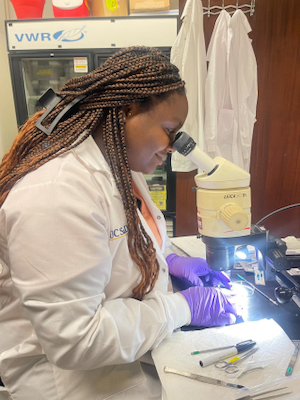Kiirah Green is a master's student at Scripps Institution of Oceanography at the University of California San Diego, beginning her second year in the marine biology program. Green was raised in San Bernardino, Calif., and earned her bachelor’s degree in marine science from Coastal Carolina University. She works with her advisor, Scripps marine biologist Greg Rouse, in his benthic invertebrates lab, known as Spineless. Research in the lab focuses on phylogenetics, the study of evolutionary relationships among biological entities, and Green’s research focuses on deep-sea worms.
explorations now: Why did you choose to attend Scripps?
Kiirah Green: I have always wanted to be a marine biologist since I was a little girl. Attending Scripps has always been a dream of mine, and I am beyond grateful I get to attend. The professors at Scripps are so passionate about what they do, and it is reflected in their research.
en: What are you researching at Scripps?
KG: My research focuses on the phylogenetic and taxonomic analysis of a group of deep-sea annelids, which are ringed or segmented worms, known from the genus Lacydonia. I use molecular evidence, such as DNA, to create phylogenetic trees—like family trees—to explore the evolutionary relationships between organisms and show who is more closely related to whom. Specifically I am describing several new species that will greatly increase the diversity of this group! The genus Lacydonia was first described in 1875 in the Mediterranean Sea’s Gulf of Marseille. Since then, there have been only 15 species described. This entire genus has wide bathymetric ranges of depth (25-5,690 meters [80-18,700 feet]) ) and can be found in almost every ocean basin.
en: How did you become interested in science and your field of study?
KG: I have always been interested in marine science since I was a little girl, and for as long as I can remember, I have known this is what I wanted to do. When I finished my bachelor's degree and decided to go back to school, I was confident in choosing what I wanted my focus to be. I have always been drawn to the deep sea. I personally view it as the last frontier in which there is a vast portion that we do not know about, and so much to learn and explore—and I want to be a part of that!

en: What’s life like as a Scripps student? Describe a typical day.
KG: A typical day for me involves going into the lab to do DNA extractions on deep-sea annelids. Or, you can find me running a polymerase chain reaction (PCR), which is a laboratory procedure used to amplify a certain sequence of DNA. You use a specific set of primers to copy a specific segment of a DNA sequence. You can also catch me in front of a microscope for hours exploring and comparing the morphological characteristics of the worms, or the relationship between their structures. Not only do we use molecular evidence to support the claim of ‘new species,’ it is also important to examine the morphology of each species and determine if there are distinguishable characteristics that set the species apart. Because some are from different locations and different depths, it is likely that there will be some morphological characteristics that separate one species from another. I may also be doing phylogenetic analyses on my DNA sequences to understand the taxonomic relationships within the group. When I am done with all that, I’ll reward myself with a snorkel or scuba dive at La Jolla Shores with my friends, and then end the day with good food.
en: What’s the most exciting thing about your work (in the field or in the lab)?
KG: The most exciting thing about my work has to be the new species descriptions! The work that is done in my lab shows that our knowledge about the ocean, specifically the deep sea, is in a state of constant growth, which needs protecting. With the new species descriptions, we show that the diversity of organisms in the deep sea can be endemic, complex, and fragile. Through the interconnected nature of the ocean, it is important to study how these organisms live and contribute to all the aspects that are necessary for ocean sustainability before they are completely gone.
en: Are there any role models or mentors who have helped you along the way?
KG: I have had so many role models in life, from my parents who have shaped me into the person I am today, to professors who have challenged my abilities, allowing me to grow into the student I am today. Last but not least, my previous work managers have taken the time to share their skills with me beyond the workplace and become great sources of guidance in my life! I've worked as a marine science instructor on Catalina Island, and not only was the experience something completely new to me, my manager did an amazing job at pushing me out of my comfort zone. Nevertheless, the people in my lab, my advisor Greg Rouse, the Benthic Invertebrates Collection Manager Charlotte Seid—who is a wealth of knowledge, and the PhD students in my lab have all helped me along the way. Without all of them, I can’t imagine how successful my experience would be at this point.
en: What are some of the challenges you face as a student?
KG: As a first-generation student, I have faced many challenges, but I often remind myself of the great experiences I have been offered. I try my best to make the most of it!
en: What are your plans post-Scripps?
KG: My plan is to gain more experience with the new skills I have acquired and continue on to a PhD. I want to keep learning about the deep sea and make a contribution in any way possible.
You can find Green on Instagram at @Kiirahgreen.



